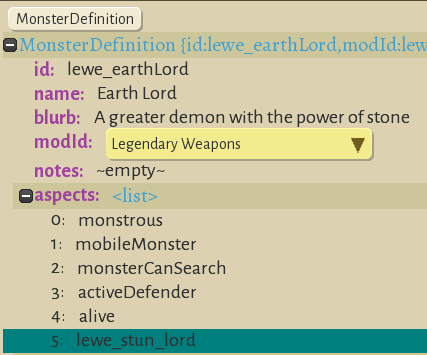Difference between revisions of "Modding replace faction"
(Created page with "This page walks through the process of adding a new ability to a custom monster. The focus is on getting something simple which you can see in the game, and adding more detai...") |
|||
| Line 1: | Line 1: | ||
This page walks through the process of | This page walks through the process of replacing all the monsters in a faction. The focus is on getting something simple which you can see in the game, and adding more details later. The description and screenshots are current as of July 2020, early access version 0.23+148 Triss Thornfire. | ||
== | ==Main concept== | ||
Today, modders cannot add factions. The game is hard-coded with five factions. But, you can replace all the monsters in a faction and change the name. Why would you do this, instead of just adding new monsters without factions? Because of calamities. In other games, you can make a large "family" of monsters with stronger and stronger abilities, and use an "encounter table" that maps the party's power level against the monster types. So, low level parties will encounter easy monsters and high level parties will encounter hard monsters. In Wildermyth, for the most part, low and high level parties encounter the same monsters; but calamities make the monsters stronger or add special effects. Hopefully, this makes encounters interesting for parties of all levels automatically. | |||
If you want to add one monster for one event, you can do that, but you can't really tune it to be an interesting encounter for both a low level party and high level party. It's better to redefine a faction, and use the calamity system to make the monsters stronger as the party grows stronger. | |||
Here are the steps to replacing a faction. | |||
<ol> | |||
<li>Add monsters. The basics of adding monsters are described in this tutorial: [[Modding add monster|Adding a monster]]. Most factions have 5-9 different monsters.</li> | |||
<li>Change the faction name. This has some limitations; As of today, your name won't show up everywhere, and there are some images you can't change.</li> | |||
<li>Update the calamities.</li> | |||
<li>Add the "tracks" for generating monsters.</li> | |||
==Change the faction name== | |||
== | NYI | ||
==Update the calamities== | |||
NYI | |||
==Add tracks== | |||
NYI | |||
<syntaxhighlight lang="json"> | <syntaxhighlight lang="json"> | ||
[ | [ | ||
| Line 19: | Line 35: | ||
] | ] | ||
</syntaxhighlight> | </syntaxhighlight> | ||
[[File:ModdingMonsterAspect.PNG]] | [[File:ModdingMonsterAspect.PNG]] | ||
==Seeing the effect in game== | ==Seeing the effect in game== | ||
| Line 93: | Line 42: | ||
# Choose tools from the game main menu, then select combat lab. This will give you a chessboard-like battle map with a few characters and monsters already spawned. | # Choose tools from the game main menu, then select combat lab. This will give you a chessboard-like battle map with a few characters and monsters already spawned. | ||
# In the "Generate a unit" dropdown at the left, choose "Davea's monster" and then click Side A. Your monster should appear: | # In the "Generate a unit" dropdown at the left, choose "Davea's monster" and then click Side A. Your monster should appear: | ||
[[Category:Modding]] | [[Category:Modding]] | ||
[[Category:Modding Guides]] | [[Category:Modding Guides]] | ||
Revision as of 10:29, 2 July 2020
This page walks through the process of replacing all the monsters in a faction. The focus is on getting something simple which you can see in the game, and adding more details later. The description and screenshots are current as of July 2020, early access version 0.23+148 Triss Thornfire.
Main concept
Today, modders cannot add factions. The game is hard-coded with five factions. But, you can replace all the monsters in a faction and change the name. Why would you do this, instead of just adding new monsters without factions? Because of calamities. In other games, you can make a large "family" of monsters with stronger and stronger abilities, and use an "encounter table" that maps the party's power level against the monster types. So, low level parties will encounter easy monsters and high level parties will encounter hard monsters. In Wildermyth, for the most part, low and high level parties encounter the same monsters; but calamities make the monsters stronger or add special effects. Hopefully, this makes encounters interesting for parties of all levels automatically.
If you want to add one monster for one event, you can do that, but you can't really tune it to be an interesting encounter for both a low level party and high level party. It's better to redefine a faction, and use the calamity system to make the monsters stronger as the party grows stronger.
Here are the steps to replacing a faction.
- Add monsters. The basics of adding monsters are described in this tutorial: Adding a monster. Most factions have 5-9 different monsters.
- Change the faction name. This has some limitations; As of today, your name won't show up everywhere, and there are some images you can't change.
- Update the calamities.
- Add the "tracks" for generating monsters.
- If you haven't already done so, enable developer mode. (Save and exit before doing this.) In file explorer, create an empty file under steam\steamapps\common\Wildermyth called devmode.txt.
- Choose tools from the game main menu, then select combat lab. This will give you a chessboard-like battle map with a few characters and monsters already spawned.
- In the "Generate a unit" dropdown at the left, choose "Davea's monster" and then click Side A. Your monster should appear:
Change the faction name
NYI
Update the calamities
NYI
Add tracks
NYI
[
{
"modId": "lewe",
"id": "lewe_stun_lord",
"effects": [ "lewe_stun_lord" ],
"importance": -1,
}
]
